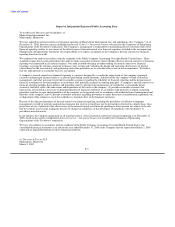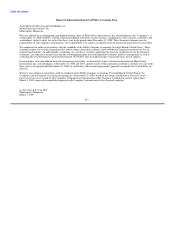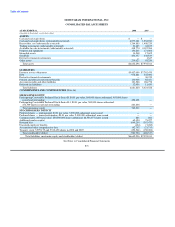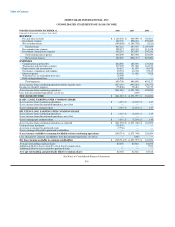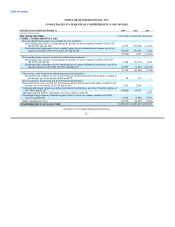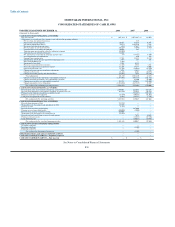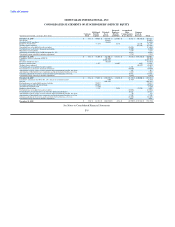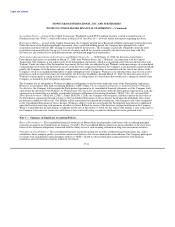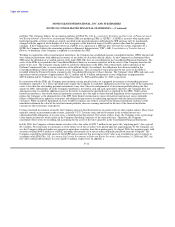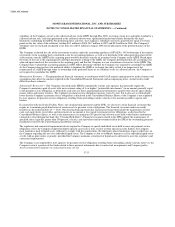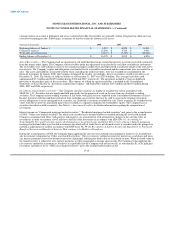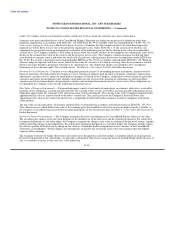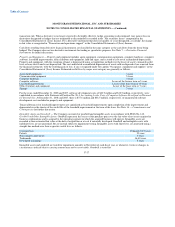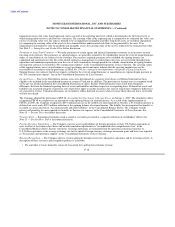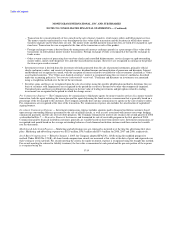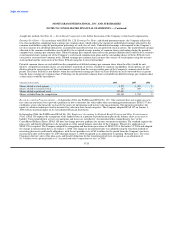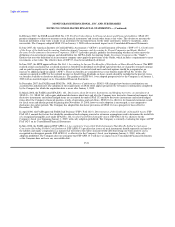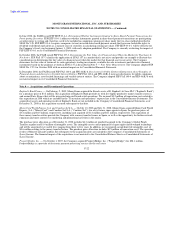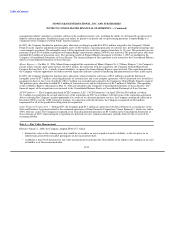MoneyGram 2008 Annual Report Download - page 99
Download and view the complete annual report
Please find page 99 of the 2008 MoneyGram annual report below. You can navigate through the pages in the report by either clicking on the pages listed below, or by using the keyword search tool below to find specific information within the annual report.
Table of Contents
MONEYGRAM INTERNATIONAL, INC. AND SUBSIDIARIES
NOTES TO CONSOLIDATED FINANCIAL STATEMENTS — (Continued)
subsidiary of the Company served as the collateral advisor to the QSPE through May 2008, receiving certain fees and rights standard to a
collateral advisor role. Activities performed as the collateral advisor were significantly limited and entirely defined by the legal
documents establishing the QSPE. For performing these activities, the Company's subsidiary received a quarterly fee equal to 10 basis
points on the fair value of the collateral, totaling $0.3 million in 2008, $0.7 million in 2007 and $0.2 million in 2006. The Company's
subsidiary also received and recognized a one-time fee of $0.4 million in August 2006 for the placement of the preferred shares of the
QSPE.
The Company evaluated the sale of the investment securities under the accounting guidance of SFAS No. 140 to determine if the transfer
of securities to the acquiring party constituted a sale for accounting purposes, as well as to determine if the subsequent placement of the
sold securities into the QSPE by the acquiring party would be deemed a transfer of securities by the Company to the QSPE. Based upon
the terms of the sale to the acquiring party and legal documents relating to the QSPE, the Company determined that sale accounting was
achieved upon transfer of the securities to the acquiring party and that the Company was not a transferor of securities to the QSPE. The
Company then evaluated the accounting guidance of FIN 46R to determine whether the Company was required to consolidate the QSPE.
As the Company does not have the unilateral ability to liquidate the QSPE or to change the entity so that it no longer meets the
requirements of a QSPE through either its ownership of the preferred shares or its subsidiary's role as collateral advisor, the Company is
not required to consolidate the QSPE.
Management Estimates — The preparation of financial statements in conformity with GAAP requires management to make estimates and
assumptions that affect the amounts reported in the Consolidated Financial Statements and accompanying notes. Actual results could
differ from those estimates.
Substantially Restricted — The Company's licensed entity MPSI is regulated by various state agencies that generally require the
Company to maintain a pool of assets with an investment rating of A or higher ("permissible investments") in an amount generally equal
to the payment service obligation, as defined by each state, for those regulated payment instruments, namely teller checks, agent checks,
money orders and money transfers. The regulatory payment service obligations measure varies by state, but in all cases is substantially
lower than the Company's payment service obligations as disclosed in the Consolidated Balance Sheets as the Company is not regulated
by state agencies for payment service obligations resulting from outstanding cashier's checks or for amounts payable to agents and
brokers.
In connection with our Senior Facility, Notes, one clearing bank agreement and the SPEs, we also have certain financial covenants that
require us to maintain pre-defined ratios of certain assets to payment service obligations. The financial covenants under our credit
facilities are described in Note 10 — Debt. One clearing bank agreement has financial covenants that include the maintenance of total
cash, cash equivalents, receivables and investments in an amount at least equal to payment service obligations, as disclosed in the
Consolidated Balance Sheets, as well as the maintenance of a minimum 103 percent ratio of total assets held at that bank to instruments
estimated to clear through that bank (the "Clearing Bank Ratio"). Financial covenants related to the SPEs include the maintenance of
specified ratios, typically greater than 100 percent, of cash, cash equivalents and investments held in the SPE to the outstanding payment
instruments issued by the related financial institution customer.
The regulatory and contractual requirements do not require the Company to specify individual assets held to meet our payment service
obligations, nor is the Company required to deposit specific assets into a trust, escrow or other special account. Rather, the Company
must maintain a pool of liquid assets sufficient to comply with the requirements. No third party places limitations, legal or otherwise, on
the Company regarding the use of its individual liquid assets. The Company is able to withdraw, deposit or sell its individual liquid assets
at will, with no prior notice or penalty, provided the Company maintains a total pool of liquid assets sufficient to meet the regulatory and
contractual requirements.
The Company is not regulated by state agencies for payment service obligations resulting from outstanding cashier's checks; however, the
Company restricts a portion of the funds related to these payment instruments due to contractual arrangements and Company policy.
Assets restricted for regulatory or contractual reasons are not
F-13


